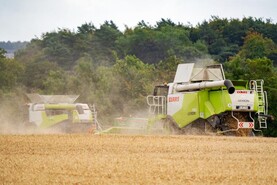Global grain markets are set for a positive 18 to 24 months due to increased demand from China, economic recovery and ongoing dry weather concerns.
Grain market dynamics have changed dramatically in 2020, moving from a bearish position in spring to a bullish outlook in the autumn.
This is according to CEO of AgResources Dan Basse, who spoke at this year’s online R&H Hall conference. He outlined how grain markets have rallied over the past month to reach four-year highs.
China buys what China needs
Dan explained that China is the main driving force behind this dramatic change in market outlook. Due to generous grant aid and strong market prices, investment in rebuilding the country’s sow heard has been rapid.
By mid-2021, it is anticipated that Chinese sow production will reach post-African swine flu (ASF) levels and, pending market conditions, may increase even further.
The new bio-secure sow facilities being built in the country see a move to intensive western-style production. This, in turn, is dramatically increasing the nation's demand for soya bean and maize.

The recovery of Chinese sow production will result in a significant increase in grain demand.
Chinese maize imports are likely to reach 25 to 30 million tonnes by next year, well above the average of 8 million tonnes.
Much of this will come from the US, which is now possible due to the revamped US-China trade deal. An amount will also come from South American countries.
Weather impact
Dry weather in the US and Black Sea region has affected crop yields this year. While the US maize crop was still one of the highest on record, it was significantly lower than first predicted.
The Ukrainian harvest is around 70% complete and is proving to be one of the worst harvests on record. Yields are down by an average of 30% due to summer drought.
However, the real unknown is the impact which dry weather will have on the Brazilian and Argentina maize and soya bean crop.
This is one to keep a close eye on, as crops are entering a particularly sensitive period and will incur yield penalties if moisture stress continues.
Prices
The increase demand from China, dry weather impact on crops, coupled with an expected COVID-19 recovery next year means maize and soya bean stocks are likely to come under pressure for the next 18 to 24 months.
Dan explained that, under his current estimation, there is scope for maize and soya bean price increases over the coming year, pending the severity of the impact of dry weather in South America.
To put this in context, US soya beans have the potential to reach $13.25/bushel. Currently, soya bean futures are trading around $11.78/bushel.
US maize has the potential to reach $5.60 to $6.00/bushel and futures are trading around $4.30/bushel.
Global grain markets are set for a positive 18 to 24 months due to increased demand from China, economic recovery and ongoing dry weather concerns.
Grain market dynamics have changed dramatically in 2020, moving from a bearish position in spring to a bullish outlook in the autumn.
This is according to CEO of AgResources Dan Basse, who spoke at this year’s online R&H Hall conference. He outlined how grain markets have rallied over the past month to reach four-year highs.
China buys what China needs
Dan explained that China is the main driving force behind this dramatic change in market outlook. Due to generous grant aid and strong market prices, investment in rebuilding the country’s sow heard has been rapid.
By mid-2021, it is anticipated that Chinese sow production will reach post-African swine flu (ASF) levels and, pending market conditions, may increase even further.
The new bio-secure sow facilities being built in the country see a move to intensive western-style production. This, in turn, is dramatically increasing the nation's demand for soya bean and maize.

The recovery of Chinese sow production will result in a significant increase in grain demand.
Chinese maize imports are likely to reach 25 to 30 million tonnes by next year, well above the average of 8 million tonnes.
Much of this will come from the US, which is now possible due to the revamped US-China trade deal. An amount will also come from South American countries.
Weather impact
Dry weather in the US and Black Sea region has affected crop yields this year. While the US maize crop was still one of the highest on record, it was significantly lower than first predicted.
The Ukrainian harvest is around 70% complete and is proving to be one of the worst harvests on record. Yields are down by an average of 30% due to summer drought.
However, the real unknown is the impact which dry weather will have on the Brazilian and Argentina maize and soya bean crop.
This is one to keep a close eye on, as crops are entering a particularly sensitive period and will incur yield penalties if moisture stress continues.
Prices
The increase demand from China, dry weather impact on crops, coupled with an expected COVID-19 recovery next year means maize and soya bean stocks are likely to come under pressure for the next 18 to 24 months.
Dan explained that, under his current estimation, there is scope for maize and soya bean price increases over the coming year, pending the severity of the impact of dry weather in South America.
To put this in context, US soya beans have the potential to reach $13.25/bushel. Currently, soya bean futures are trading around $11.78/bushel.
US maize has the potential to reach $5.60 to $6.00/bushel and futures are trading around $4.30/bushel.







 This is a subscriber-only article
This is a subscriber-only article










SHARING OPTIONS: